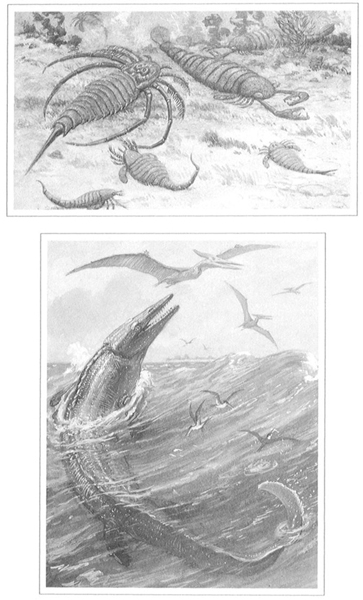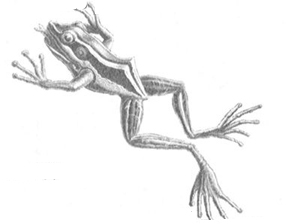Full House (2 page)
Part One
How SHALL WE READ AND SPOT A TREND?
1
Huxley’s Chessboard
We reveal ourselves in the metaphors we choose for depicting the cosmos in miniature. Shakespeare, unsurprisingly, saw the world as "a stage, and all the men and women merely players." Francis Bacon, in bitter old age, referred to external reality as a bubble. We can make the world really small for various purposes, ranging from religious awe before the even grander realm of God ("but a small parenthesis in eternity" according to Sir Thomas Browne in the mid-seventeenth century), to simple zest for life (as stated so memorably in a conversation between the paragons for such a position, Pistol and Falstaff: "the world’s mine oyster, which I with sword will open").
We should therefore not be surprised that Thomas Henry Huxley, the arch rationalist and master of combat, should have chosen a chessboard for his image of natural reality:
The chess board is the world, the pieces are the phenomena of the universe, the rules of the game are what we call the laws of Nature. The player on the other side is hidden from us. We know that his play is always fair, just, and patient. But also we know, to our cost, that he never overlooks a mistake, or makes the smallest allowance for ignorance. (From A Liberal Education, 1868.)
This image of nature as a tough but fair adversary, beatable by the two great weapons of observation and logic, underlies Huxley’s most famous pronouncement that "science is simply common sense at its best; that is, rigidly accurate in observation and merciless to fallacy in logic." (From his great popular work The Crayfish, 1880.)
Huxley’s metaphor fails—and our task in revealing nature becomes correspondingly harder—because we cannot depict the enterprise of science as Us against Them. The adversary at the other side of the board is some complex combination of nature’s genuine intractability and our hidebound social and mental habits. We are, in large part, playing against ourselves. Nature is objective, and nature is knowable, but we can only view her through a glass darkly—and many clouds upon our vision are of our own making: social and cultural biases, psychological preferences, and mental limitations (in universal modes of thought, not just individualized stupidity).
The human contribution to this equation of difficulty becomes ever greater as the subject under investigation comes closer to the heart of our practical and philosophical concerns. We may be able to apply maximal objectivity to taxonomic decisions about species of pogonophorans in the Atlantic Ocean, but we stumble in considering the taxonomy of fossil human species or, even worse, the racial classification of Homo sapiens.
Thus, when we tackle the greatest of all evolutionary questions about human existence—how, when, and why did we emerge on the tree of life; and were we meant to arise, or are we only lucky to be here—our prejudices often overwhelm our limited information. Some of these biased descriptions are so venerable, so reflexive, so much a part of our second nature, that we never stop to recognize their status as social decisions with radical alternatives—and we view them instead as given and obvious truths.
My favorite example of unrecognized bias in depicting the history of life resides quite literally in the pictures we paint. The first adequate reconstructions of fossil vertebrates date only from Cuvier’s time, in the early nineteenth century. Thus the iconographic tradition of drawing successive scenes to illustrate the pageant of life through time is not even two centuries old. We all know these series of paintings—from a first scene of trilobites in the Cambrian sea, through lots of dinosaurs in the middle, to a last picture of Cro-Magnon ancestors busy decorating a cave in France. We have viewed these sequences on the walls of natural history museums, and in coffee-table books about the history of life. Now what could be wrong, or even strongly biased, about such a series? Trilobites did dominate the first faunas of multicellular organisms; humans did arise only yesterday; and dinosaurs did flourish in between.
Consider three pairs of scenes spanning a century of this genre, and including the three most famous practitioners of all time. Each shows a Paleozoic and a Mesozoic marine scene. In each, the Paleozoic tableau features invertebrates, while the Mesozoic scene shows only marine reptiles that have descended from terrestrial forms. The first pair comes from a work that established the genre in the early 1860s—Louis Figuier’s La terre avant le déluge (The World Before the Deluge; see Rudwick’s fascinating book, Scenes from Deep Time, for a survey of this genre’s foundation in the nineteenth century). The second is the canonical American version, painted by Charles R. Knight, greatest artist of prehistoric life, for an article in National Geographic Magazine (February 1942), and titled Parade of Life Through the Ages. The last pair represents the equally canonical European work of the Czech artist Z. Burian in his 1956 work written with paleontologist J. Augusta and entitled Prehistoric Animals.
So why am I complaining? No vertebrates yet lived in the early Paleozoic, and marine reptiles did return to the sea during dinosaur days in the Mesozoic. The paintings are "right" in this narrow sense. But nothing can be more misleading than formally correct but limited information drastically yanked out of context. (Remember the old story about the captain who disliked his first mate and recorded in the ship’s log, after a unique episode, "First mate was drunk today." The mate begged the captain to remove the passage, stating correctly that this had never happened before and that his employment would be jeopardized. The captain refused. The mate kept the next day’s log, and he recorded, "Captain was sober today.")
As for this nautical tale, so for the history of life. What can be more misleading than the representation of something small as everything typical? All prominent series of paintings in this genre of prehistoric art— there are no exceptions, hence the example’s power—claim to be portraying the nub or essence of life’s history through time. They all begin with a scene or two of Paleozoic invertebrates. We note our first bias even here, for the prevertebrate seas span nearly half the history of multicellular animal life, yet never commandeer more than 10 percent of the pictures. As soon as fishes begin to prosper in the Devonian period, underwater scenes switch to these first vertebrates—and we never see another invertebrate again for all the rest of the pageant (unless a bit-playing ammonite squeezes into the periphery of a Mesozoic scene). Even the fishes get short shrift (literally), for not a single one ever appears again (except as fleeing prey for an ichthyosaur or a mosasaur) after the emergence of terrestrial vertebrate life toward the end of the Paleozoic era.
Now, how many people have ever stopped to consider the exceedingly curious and unrepresentative nature of such limited pageantry? Invertebrates didn’t die or stop evolving after fishes appeared; much of their most important history unrolls in contemporaneous partnership with marine vertebrates. (For example, the most fascinating and portentous episodes of life’s history—the five largest mass extinctions—are all best recorded by changes in invertebrate faunas.) Similarly, fishes didn’t die out or stop evolving just because one lineage of peripheral brethren managed to colonize the land. To this day, more than half of all vertebrates are fishes (more than 20,000 living species). Isn’t it absurd to eliminate a vertebrate majority from all further pictorial representation just because one small lineage changed its abode to land?

FIGURE 1 Three paired views of artistic representations of the history of life to show the unchanging biases that pervade this genre. The three pairs come from the work of Figuier in the 1860s, Knight in the 1940s, and Augusta and Burian in 1956. The first member of each pair shows invertebrates from the early history of multicellular life. The second figure in each pair shows a marine scene from the Mesozoic Era (time of domination of dinosaurs on land). No fish or invertebrates are shown in the Mesozoic scene, but only reptiles that have returned to the marine environment.


The story of terrestrial vertebrates is just as egregiously biased. First of all, once vertebrates colonize the land, oceans disappear from life’s history, with one "exception" (documented in Figure 1) that actually illustrates the rule: If a "highly evolved" land creature returns to the sea, it may be shown as a representative of diversity within a stage of progress. Thus, Mesozoic marine reptiles may be depicted as contemporaries of ruling dinosaurs on land, but fishes living at the same time are invisible because their stage has been superseded in evolution’s upward march. Tertiary whales are in because mammals then rule the land, but both marine reptiles and fishes of the same period are out as bypassed forms.
Second, the sequence of land animals only displays our anthropocentric view of shifting mastery through time, not a fair record of changing diversity. Fishes are banished once amphibians and reptiles colonize the land—but why punish fishes for what a few odd relatives did in disparate and unknown environments, especially when oceans, continuously dominated by fishes among vertebrates, cover some 70 percent of the earth’s surface? The origin of mammals extirpates all amphibians and reptiles from view, even though they continue to flourish and to influence mammalian life in ways ranging from Mosaic plagues to the temptation of Eve. The last few paintings always depict humans, even though we are but one species in a small group of mammals (the order Primates contains about two hundred species among four thousand or so for all mammals), while the greatest successes of mammalian evolution—bats, rats, and antelopes— remain invisible.
Let me not carp unfairly. If these pageantries only claimed to be illustrating the ancestry of our tiny human twig on life’s tree, then I would not complain, for I cannot quarrel unduly with such a parochial decision, stated up front. But these iconographic sequences always purport to be illustrating the history of life, not a tale of a twig. Consider the titles of the three series partly depicted in Figure 1: "The earth before the flood," "The parade of life through the ages," and "Prehistoric animals." An analogy might help in illustrating the oddity of such a pageant: Suppose that we wanted to stage a parade illustrating the growth of America’s coterminous forty-eight states through time. Would we let the float for New England ride only for the first mile, and then withdraw it permanently from view? Would we then add the Northwest Territories, the Louisiana Purchase, and the western lands in sequence, permitting only one float at a time by dismantling the preceding float after each new introduction? Would we be adequately showing the apotheosis of American expansion if the parade ended with a single float celebrating that little sliver of the southwest known as the Gadsden Purchase?
Similarly, much as we may love ourselves, Homo sapiens is not representative, or symbolic, of life as a whole. We are not surrogates for arthropods (more than 80 percent of animal species), or exemplars of anything either particular or typical. We are the possessors of one extraordinary evolutionary invention called consciousness—the factor that permits us, rather than any other species, to ruminate about such matters (or, rather, cows ruminate and we cogitate). But how can this invention be viewed as the distillation of life’s primary thrust or direction when 80 percent of multicellularity (the phylum Arthropoda) enjoys such evolutionary success and displays no trend to neurological complexity through time—and when our own neural elaboration may just as well end up destroying us as sparking a move to any other state that we would choose to designate as "higher"?

